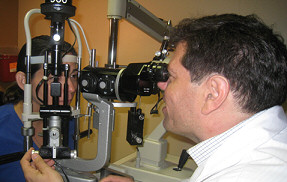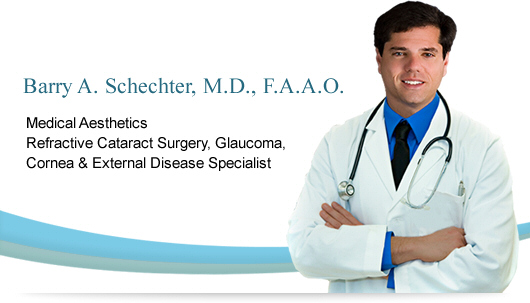Newsletter Issue 12 | Jun 2012
Florida Eye News and Views Summer 2012

Dear Readers:
Summer is in full swing and extended daylight hours mean there’s more time for indulging in our favorite Florida pastimes. It also means even more sun exposure for your eyes and so, as we do every summer, we remind you to please wear appropriate sunglasses while you’re enjoying outside activities. Taking care of your eyes now can help keep debilitating eye conditions at bay.
The majority of this issue focuses on cataract care, as June is cataract awareness month. Below you’ll find information on who’s at risk for developing cataracts (not just the aging population!), what symptoms to be aware of, your personal risk factors, what to expect at an eye exam, and the latest news on cataract surgical procedures.
We hope you find the information in our newsletter useful. As always your feedback is appreciated.
From all of us at Florida Eye, have a wonderful, safe summer!

Gwen Cohan
Director of Marketing & Public Relations
In this Issue:
Cosmetic Front: Ouchless Needle Craze!! »
Clinical Trial Updates
From Dr. Barry Schechter:
We are currently enrolling patients for one blepharitis study which will be six months long. Patients must be over 18 and have symptoms. Patients will be paid $30 per completed visit with a total of ten visits.
From Dr. Randy Katz:
We have a wet AMD for treatment naïve patients that is Lucentis plus a study drug.
Future Studies…
We will be having another wet study coming up and another dry study as well. We will send out an email when these studies open.
As with any of our studies at Florida Eye, if you refer patients and they are enrolled, we will update you on the progress of your patient and return the patient to your care at the end of the study. The sponsor covers all expenses and costs of these trials.
If you would like to discuss these studies further, please contact our study coordinator Debbie Rankin at (561) 736-5055.
Cataract Report
Today, more than 22 million Americans age 40 and older have a cataract, a condition which causes a ‘clouding’ of the eye’s lens. This clouding blocks or changes the passage of light into the eye. According to the National Eye Institute, by age 80 more than half of all Americans will either have a cataract or have had cataract surgery.
Possible Risk Factors
- Intense heat or long-term exposure to UV rays from the sun
- Certain diseases, such as diabetes
- Obesity
- High blood pressure
- Inflammation in the eye
- Hereditary influences
- Long-term steroid use
- Eye injuries
- Other eye diseases
- Smoking
Symptoms
Early symptoms of cataracts may include cloudy or blurry vision. Lights may cause a
glare, seem too dim or seem too bright. Patients may also find it difficult to read or
drive, especially at night, or may have to change his or her eyeglass prescription often.
Eye Exam

To find out if you have cataracts, your eye doctor will want to:
- Find out your general medical history.
- Find out your specific eye history, including problems and symptoms.
- Test your vision (visual acuity).
- Test your side vision (peripheral vision).
- Test your eye movement.
- Test you for glaucoma (by measuring the eye’s internal pressure).
- Do a microscopic exam of the front of the eye (using something called a slit lamp) to assess the density of the cataract and how it interferes with light passing through the lens.
- Widen (dilate) the pupils of your eyes to examine the retina, the optic nerve (which carries visual messages from the retina to the brain) and the macula (responsible for the best part of central vision).
- Test you to see how glare affects your vision.
After this exam, your eye doctor will determine whether you have cataracts, how much they interfere with your vision, whether surgery will help, and what types of treatment and lens replacements are best for you.
Surgical Procedure
Unfortunately, there are no medications or other treatment options besides surgery to remove a cataract and the most popular method utilized today is a procedure called phacoemulsification – or phaco – which is the primary standard of care in the industry. Florida Eye’s Director of Cornea & Cataract Service, Barry Schechter, M.D.F.A.A.O., attributes the popularity of the procedure to its minimally invasive, quick post-op recovery reputation.
Phacoemulsification involves removing the eye’s natural lens while leaving in place the back of the capsule, which holds the lens in place. “The difference with phacoemulsification,” says Dr. Schechter, “is that the cataract is broken into tiny pieces and suctioned from the eye through a smaller incision than is used in other forms of cataract surgery.”
“Healing and rehabilitation are faster with this procedure, and there is little, if any, discomfort,” adds Dr. Schechter. “At Florida Eye we perform the majority of our cataract surgeries utilizing this procedure.” For more info, see Cataract Treatments & Designer IOLs.
Cataracts in the Young
Congenital cataracts occur in newborn babies for many reasons that can include inherited tendencies, infection, metabolic problems, diabetes, trauma, inflammation or drug reactions. However, trauma associated with events, such as a blow to the eye, is the underlying cause in 40 percent of cases of cataracts in older children. Without early intervention, congenital cataracts cause “lazy eye” or amblyopia. This condition then can lead to other eye problems such as nystagmus, strabismus and inability to fix a gaze upon objects.
“Such problems can profoundly impact learning ability, personality and even appearance, ultimately affecting a child’s entire life. For these and many other reasons, make sure your child’s eyes are examined regularly and as soon as possible after your baby is born,” says Florida Eye’s Pediatric & Adult Strabismus Specialist Lee Friedman, M.D. “An early diagnosis is absolutely in a child’s best interests.”
Patient Success Story – A Teen’s Experience with Cataracts
Florida Eye Refractive Cataract Surgeon & Glaucoma Specialist Jason Gorscak M.D, remembers a recent patient, Diana James, who was born with a cataract in one eye. “Diana was eleven when she really noticed her sight deteriorating,” says Dr. Gorscak. “Congenital cataracts run in the family, on her father’s side.” And according to Diana, “I wasn’t the only sibling to have the condition. One of my sisters and her three children were born with cataracts, and a brother of mine had them as well.”
When Diana came to see Dr. Gorscak she told him she couldn’t see anything far away, and finally, even with her glasses she could barely read the blackboard in school. “I had to scrunch my eyes to see, and I wore my glasses even though I hated them.” Eventually Diana says she couldn’t see the blackboard even with her glasses, and she was having difficulties with everything from reading to working on the computer.
Dr. Gorscak removed Diana’s cataract as an outpatient procedure at the Institute’s state-of-the-art Boynton Beach Ambulatory Center.
And the results? “I am so thrilled,” says Diana. “Dr. Gorscak said I’d most likely still need glasses but I don’t, and I can see so much better than I ever did before. Everything is so clear!”
Eye Care Questions
Dear Dr. Schechter:
Is there such a thing as waiting too long to have a cataract removed?
Answer

I usually advise patients to wait until their vision is frustrating on a daily basis, however, as a cataract matures, it does become denser and incrementally more difficult to remove. This requires more energy and may lead to prolonged inflammation or even intraoperative complications. And there are times where a cataract can induce glaucoma or impair our view of the retina, and under those circumstances, your ophthalmologist may advise cataract surgery even if you are not particularly visually symptomatic. Ultimately, a patient and their ophthalmologist must work together to weigh the risks of surgery against the likely visual benefit.
Dear Dr. Katz:
I heard that floaters can now be removed by blasting them to small particles and vacuuming them out. Have you heard of this procedure and does it work?
Answer

Ophthalmologists are certainly capable of performing this microsurgery. However, this would be major ophthalmological surgery with substantial immediate and long-term risk that does not outweigh the minor benefit. This is almost never needed for vision as most floaters will become less apparent over time.
Cosmetic News
Dr. Schechter Now Using the Ouchless® Needle!!

If you haven’t heard about this revolutionary device that makes painful injections a thing of the past, check out the recent article on Dr. Schechter that was in the Boynton Forum, and for more info on this incredible no pain, time-saving device visit DrBarrySchechter.com and watch the video!! Call Derk for an appointment: (561) 736-5067.
Our patients LOVE the Ouchless® Needle!!
Final Tidbits
It’s Cool to Wear Shades
Be aware that if you are at the beach or on the ski slopes, you should wear sunglasses with a darker tint to block more light. Your risk of eye damage from the sun is greater because of reflection off the water and snow. Read the labels! Always read labels carefully and look for labels that clearly state the sunglasses block 99 to 100% of UV-A and UV-B rays.
